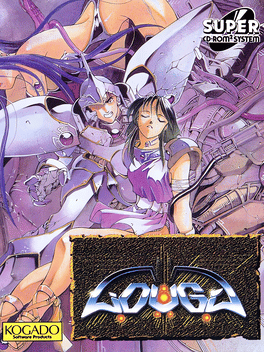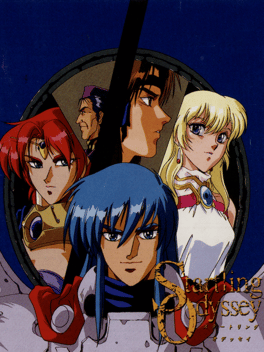New Turbografx 16 Pc Engine Cd Games - Page 4
-
Bakushou Yoshimoto ShinkiGeki
1994
The game is based on the comedy TV show Yoshimoto no Shinkigeki, which in its turn is based on a theatrical comedy show popular in Osaka and its surroundings. The game stars characters that either look like the actors from the TV show and/or resemble characters played by them. The show consists of short episodes which are depictions of comical situations, and are not related to each other story-wise. Same can be applied to the game: there is no real story, just a stretch of hilarious and intentionally impossible situations the protagonists find themselves in. -
Championship Rally
1993
Championship Rally
1993
Championship Rally is a top-down racing game. The player can choose to control real rally cars: Toyota Celica, Nissan Pulsar, Lancia Delta, and others. There are three modes in the game: time attack, high speed rally, and "adventure mode", which takes the player through a championship in Senegal. Each mode allows the player to select a car and customize its steering, gears, brakes, etc. Car controls are fairly simple, with one button assigned to accelerating and another to applying brakes. -
YuYu Hakusho Yamishoubu!! Ankoku Bujutsu Kai
1993
Despite its premise, which is reminiscent of a versus fighting game, Ankoku Bujutsukai is an arcade-style shooter. The player selects one of the five characters (Yusuke, Hiei, Kurama, Kuwabara or Genkai), and is then taken to a series of one-on-one shoot-outs in a pre-determined order. The enemy is viewed from a first-person perspective, and the player moves a cursor to aim and shoot. The gameplay system is fairly simple, allowing the player to execute three types of attacks: regular shots, charged shots, and special attacks of limited quantity. Points are received for winning fights and can be used to raise the characters' hit points, speed, or number of special moves. -
Camp California
1993
Camp California
1993
Byron the surfing bear must rescue his lil' bro and their three friends and stop a crew of rats from destroying their beach and preventing a big rock n' roll concert. Featuring music from the Beach Boys, this radical adventure is cleans up the streets and hits the beach! -
Tenshi no Uta II: Datenshi no Sentaku
1993
The second entry in the Tenshi no Uta RPG series by Telenet. -
Shin Megami Tensei
1993
Shin Megami Tensei
1993
Shin Megami Tensei is a port of the original Super Famicom game and features new highly detailed cutscenes. The gameplay uses first-person navigation of dungeons and turn-based battles against demons. The player can recruit demons as allies by talking to them rather than fighting them, and two to three demons can be fused to create new demons. -
Downtown Nekketsu Monogatari
1993
The PC Engine Super CD-ROM version of Downtown Nekketsu Monogatari (known as River City Ransom in North America, Street Gangs in Europe), released on December 24, 1993, was published by Naxat Soft and developed by KID, the same team that did the PC Engine versions of Nekketsu Kōkō Dodgeball (Super Dodge Ball), Double Dragon II: The Revenge, and Downtown Nekketsu Koushinkyoku. This version features enhanced graphics, an arranged redbook soundtrack and fully voiced characters, with the voices of Kunio and Riki performed by Ryou Horikawa and Nobutoshi Canna respectively. The player's progress is saved in this version on the PC Engine's backup memory. The rest of the game is almost identical to the Famicom version. -
Flash Hiders
1993
Flash Hiders
1993
A martial artist from the Wallace tribe named Bang Bipot and a temperamental sorceress named Tiria Rossette are on a trek across the world. The duo runs across and all but adopts Erue, an emotionally fragile young man somehow connected to an assortment of thugs, bounty hunters, and stranger things. -
Yami no Ketsuzoku: Haruka Naru Kioku
1993
Harukanaru Kioku is a re-imagining of earlier Yami no Ketsuzoku games. The basic plot follows the events that began in the first installment, but it is told in an entirely different fashion, with different scenes, dialogues, etc. For example, the game begins a short while before the starting point of the first chapter, and contains conversations between the protagonist Miyu Izawa and the murder victim Marie, which were not present in the original story. The visual style of the game is also quite different, with bright anime-like graphics atypical of the previous entries. -
Iga Ninden Ga-ou
1993
-
Double Dragon II: The Revenge
1993
The PC Engine CD version of Double Dragon II by Naxat Soft is surprisingly modeled closely after the NES game, from featuring mostly the same levels down to the rule of having no more than two enemies on screen at a time. But it does mix and match different types together, and in general extends the stages with additional hoodlums. There are a few other notable structural differences – namely, the fight on the huge moving bulldozer at the end of the forest level is missing, but to make up for its omission, the Lee brothers actually have to fight Willy before they meet their own shadows like in the arcade game. They also get to face the Shadow Master (now without the cape) on any difficulty level, although you miss out on the second round in a church and the good ending with Marion revived unless you beat the game on the Hard difficulty mode. -
Kisou Louga
1993
-
Sword Master
1993
-
Ruin: Kami no Isan
1993
Ruin: Kami no Isan
1993
Ruin: Kami no Isan is an action RPG. The player navigates Jan through top-down towns and hostile areas; the "world map" is not free-roaming, allowing only linear advancement from location to location. Hostile areas are populated by enemies who are visibly walking on screen. Unlike most Japanese RPGs, there are no separate "battle screens" in the game; the monsters are fought on the same spot they are encountered on, like in action games. However, unlike most action RPGs, there is a party in Ruin. The player controls only Jan, while the other party members act according to AI routines: attacking, casting offensive and healing spells, etc. The rest of the gameplay is traditional Japanese RPG style: acquiring better weapons and armor, automatic leveling up, linear story development, etc. -
Akumajyo Dracula Peke
1993
Akumajyo Dracula Peke is a hidden minigame that came included with Castlevania: Rondo of Blood. It is also known as Stage X "The Fate of Blood Must be Cut with the SUPER CD-ROM² ROM" (血の因縁はSUPER CD・ROM²でなければ断てない, Chi no Innen ha Super CD-ROM² ROM de Nakereba Tatenai). This minigame played instead of Rondo of Blood if the user was using the wrong kind of System Card. The game has been included in all conversions of Rondo of Blood, only differing on the methods of unlocking it between platforms. -
Magicoal
1993
Magicoal
1993
The boy Rhun and the girl Melvy live in a quiet forest village, both studying the art of magic. They enjoy a peaceful life, learning the secrets of the spirits and magical creatures populating the area. But on one fateful night, everything changes. A horde of goblins invades the village, burning it down. And it looks like the local church is in cohorts with a powerful demon bent on destruction! Before the heroes can realize what is happening, they are forced to escape into the forest, with only their magical powers at their side... Magicoal is a "pseudo-RPG", i.e. an action-adventure with some minor RPG elements (money, items, etc.), but without an experience system of any kind. It can be played in two-player cooperative mode, controlling Rhun and Melvy, or as a single-player game, choosing one of them and letting the computer AI control the other. The player(s) can switch between the two at any time. Most of the game is dedicated to exploring top-down areas populated by enemies, and dealing with them in action-b -
Galaxy Deka Gayvan
1993
Galaxy Deka Gayvan
1993
Galaxy Deka Gayvan is a brawler. Players can choose to control either of the two heroes, or both of them in a co-op mode. Like in other beat-em-up games, the player must defeat all the enemies on screen in hand-to-hand combat before being able to proceed. Both Hiro and Michiko can accumulate special energy (dropped by the enemies along with health power-ups and money) that allows them to transfer into the superheroes Gayvan and Mittchi and stay in that form until they run out of energy. The superhero forms are stronger and are able to execute special attacks. In addition, a two-player versus fighting mode is included. Players can choose either the protagonists or three enemy characters to compete against each other in one-on-one fighting. -
Startling Odyssey
1993
Startling Odyssey
1993
In Startling Odyssey, the player takes the role of a young boy named Leon. One day, his home villages is attacked by monsters. His best friend is killed, and the most powerful magician of the village is turned into stone and abducted by the monsters' leader. Leon receives the blessing of the village elder and begins his quest to avenge the death of his friend and to defeat the demonic forces that threaten the land. The game is a rather traditional Japanese RPG, with all the familiar ingredients: Leon (and his companions who later join the party) roams the world map, entering towns and dungeons, buying equipment and items, and engaging randomly appearing enemies in turn-based combat. The battles are viewed from first-person perspective. Characters can use regular attacks as well as magical spells, and the battles can be also set on Auto. -
Sylphia
1993
Sylphia
1993
Sylphia is a vertical shooter published by Tonkin House. The game draws from Greek mythology and tells the story of Sylphia, a female warrior with a tragic destiny. Her tale starts as she lays fatally wounded in the temple of Athena - merciless monsters have taken over the city and she perished as she desperately tried to protect innocent villagers. The gods, touched by the sincerity of the young woman's devotion and love, decide to give Sylphia another chance... Now turned into a Sylphid with tremendous powers, the female warrior embarks on a long journey of revenge, ready to fight for her homeland. Sylphia starts equipped with a fairly basic fire weapon that can be upgraded in various ways - four different types based on the four basic elements are available throughout the game, from Fire (Red), Air (Green), Water (Blue) and Earth (Brown). Each weapon type is associated with an additional sub-weapon which range from Homing Fireballs (Red), Reverse Fire (Blue), Ring Blades (Green) and Rotating Rocks (Brown). Sylph



















